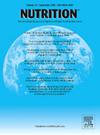不同营养干预对腹部脂肪成分和代谢参数的影响
IF 3.2
3区 医学
Q2 NUTRITION & DIETETICS
引用次数: 0
摘要
目的观察不同营养干预对腹部脂肪成分和代谢参数的影响。方法随机临床试验。我们纳入了年龄在20岁及以上的超重个体(即成人体重指数≥BMI为25kg /m2;老年人≥27 kg/m2)。参与者被分为三个干预组:第一组:热量限制与平衡的常量营养素分配。第二组:限制热量和碳水化合物。第三组:限制热量和脂质。积极对照组(第4组)仅接受营养咨询。内脏和皮下脂肪(VAT和SAT)用超声测量隔室。预测模型包括人体测量学、临床、社会人口学和行为数据。结果共有105名参与者完成了研究。在基线(T0),所有组在身体活动状况、BMI、腰围(WC)、VAT和SAT方面具有可比性。与1组和3组相比,2组报告的卡路里摄入量更高(P = 0.020)。干预后,所有组均表现出体重、BMI和WC的降低(P <;0.05)。只有第1组和第2组实现了增值税的显著减少(P <;0.05),而SAT无显著变化(P >;0.05)。增值税降低幅度从0.6%(对照组)到9.0%(组2)不等,但组间差异不显著(P = 0.202)。各组血清葡萄糖和血脂水平相似(T0, P >;0.05),没有干预改变这些代谢参数(P >;0.05)。结论三个月后,我们观察到不同营养策略的体重减轻差异很小,这表明营养咨询和/或特定的饮食方案可以有效促进体重减轻。本文章由计算机程序翻译,如有差异,请以英文原文为准。
Effects of different nutritional interventions on abdominal adiposity components and metabolic parameters
Objectives
To measure the effects of different nutritional interventions on abdominal adipose components and metabolic parameters.
Methods
A randomized clinical trial.We included individuals aged 20 years and older with excess weight (i.e., body mass index, ≥BMI, of 25 kg/m2 for adults; and ≥ 27 kg/m2 for older adults). Participants were stratified into three intervention groups: Group 1: Caloric restriction with balanced macronutrient distribution. Group 2: Caloric and carbohydrate restrictions. Group 3: Caloric and lipid restrictions. An active control group (Group 4) received nutritional counseling only. Visceral and subcutaneous adiposity (VAT and SAT) The compartments were measured using ultrasound. Anthropometric, clinical, sociodemographic, and behavioral data were included in the predictive models.
Results
A total of 105 participants completed the study. At baseline (T0), all groups were comparable in physical activity status, BMI, waist circumference (WC), VAT, and SAT. Group 2 reported a higher caloric intake, compared to Groups 1 and 3 (P = 0.020). Postintervention, all groups demonstrated reductions in weight, BMI, and WC (P < 0.05). Only Groups 1 and 2 achieved significant reductions in VAT (P < 0.05), while no significant changes were observed in SAT (P > 0.05). VAT reduction varied from 0.6% (control group) to 9.0% (Group 2), although differences between groups were not significant (P = 0.202). Serum glucose and lipid levels were similar across all groups (T0, P > 0.05), and no intervention changed these metabolic parameters (P > 0.05).
Conclusion
After three months, we observed minimal differences in weight loss across the different nutritional strategies, suggesting that nutritional counseling and/or specific dietary protocols can effectively promote weight reduction.
求助全文
通过发布文献求助,成功后即可免费获取论文全文。
去求助
来源期刊

Nutrition
医学-营养学
CiteScore
7.80
自引率
2.30%
发文量
300
审稿时长
60 days
期刊介绍:
Nutrition has an open access mirror journal Nutrition: X, sharing the same aims and scope, editorial team, submission system and rigorous peer review.
Founded by Michael M. Meguid in the early 1980''s, Nutrition presents advances in nutrition research and science, informs its readers on new and advancing technologies and data in clinical nutrition practice, encourages the application of outcomes research and meta-analyses to problems in patient-related nutrition; and seeks to help clarify and set the research, policy and practice agenda for nutrition science to enhance human well-being in the years ahead.
 求助内容:
求助内容: 应助结果提醒方式:
应助结果提醒方式:


